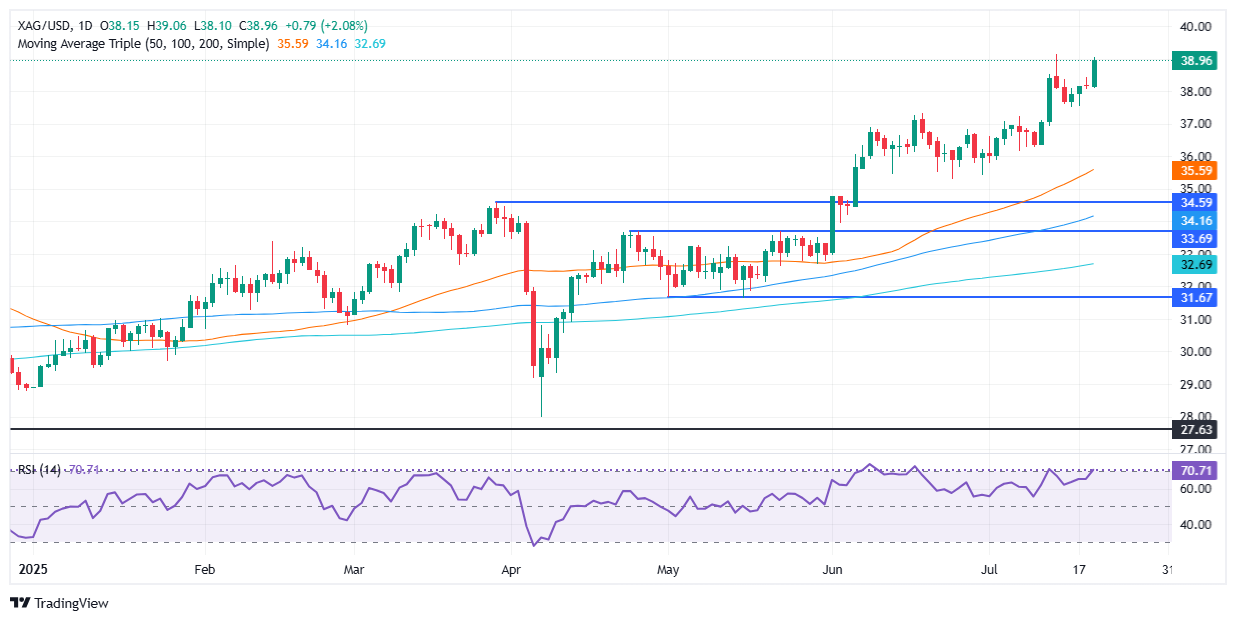Silver Price Forecast: XAG/USD soars 2% toward $39 on Dollar weakness
- Silver breaks above $38.50 as bullish RSI signals momentum toward key resistance.
- Weak US Dollar and improving market sentiment drive broad gains in precious metals.
- A move above $39.00 opens door to $39.50 and psychological $40.00 target.
Silver prices advance sharply over 2% on Monday as the North American session comes to an end, ahead of the open of the Sydney–Tokyo sessions. At the time of writing, the XAG/USD trades at $38.95 after bouncing off daily lows of $38.10 earlier in the day.
Broad US Dollar weakness, due to falling US Treasury yields and an improvement in risk appetite, sent the grey metal prices soaring, though Silver remains shy of testing the $39.00 figure.
XAG/USD Price Forecast: Technical outlook
Silver seems poised to challenge the yearly high at $39.12, after finally clearing the $38.00 and $38.50 figures on the day. The Relative Strength Index (RSI) shows that momentum is bullish with the RSI entering overbought territory but shy of reaching the most extreme level at 80.
That said, if XAG/USD surpassed $39.00, a test on the YTD high is on the cards at $39.12. Further upside is seen at $39.50 and at the $40.00 figure. Conversely, if Silver tumbles below $38.50, expect a test of the $38.00 mark, ahead of reaching the 20-day Simple Moving Average (SMA) at $37.16.
XAG/USD Price Chart – Daily

Silver FAQs
Silver is a precious metal highly traded among investors. It has been historically used as a store of value and a medium of exchange. Although less popular than Gold, traders may turn to Silver to diversify their investment portfolio, for its intrinsic value or as a potential hedge during high-inflation periods. Investors can buy physical Silver, in coins or in bars, or trade it through vehicles such as Exchange Traded Funds, which track its price on international markets.
Silver prices can move due to a wide range of factors. Geopolitical instability or fears of a deep recession can make Silver price escalate due to its safe-haven status, although to a lesser extent than Gold's. As a yieldless asset, Silver tends to rise with lower interest rates. Its moves also depend on how the US Dollar (USD) behaves as the asset is priced in dollars (XAG/USD). A strong Dollar tends to keep the price of Silver at bay, whereas a weaker Dollar is likely to propel prices up. Other factors such as investment demand, mining supply – Silver is much more abundant than Gold – and recycling rates can also affect prices.
Silver is widely used in industry, particularly in sectors such as electronics or solar energy, as it has one of the highest electric conductivity of all metals – more than Copper and Gold. A surge in demand can increase prices, while a decline tends to lower them. Dynamics in the US, Chinese and Indian economies can also contribute to price swings: for the US and particularly China, their big industrial sectors use Silver in various processes; in India, consumers’ demand for the precious metal for jewellery also plays a key role in setting prices.
Silver prices tend to follow Gold's moves. When Gold prices rise, Silver typically follows suit, as their status as safe-haven assets is similar. The Gold/Silver ratio, which shows the number of ounces of Silver needed to equal the value of one ounce of Gold, may help to determine the relative valuation between both metals. Some investors may consider a high ratio as an indicator that Silver is undervalued, or Gold is overvalued. On the contrary, a low ratio might suggest that Gold is undervalued relative to Silver.

